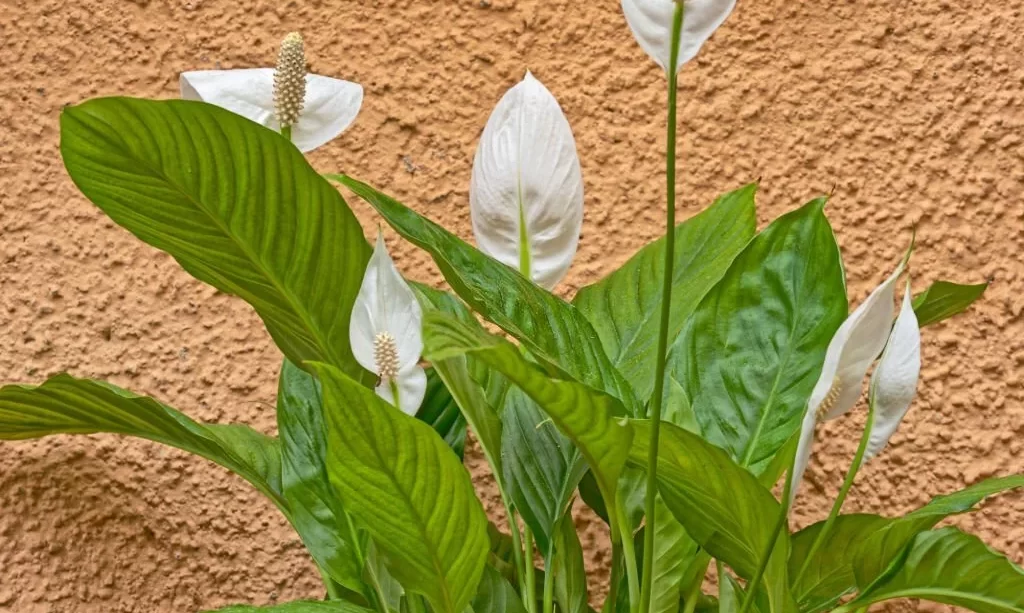Peace lilies, with their elegant white blooms and lush green leaves, have long been cherished as indoor houseplants, gracing homes and offices with their beauty. However, the curiosity about whether these beloved plants can thrive in an outdoor setting during the summer months has led many garden enthusiasts to explore new possibilities. In this article, we delve into the intriguing question of whether a peace lily can live outside in the summer. We’ll examine the unique characteristics of peace lilies, their typical indoor care requirements, and the considerations that make outdoor cultivation a potential reality.
Peace Lilies
Peace lilies, scientifically known as Spathiphyllum, are renowned for their striking appearance and air-purifying qualities. To better understand their potential for outdoor living, it’s essential to grasp their typical attributes and care needs:
- Appearance: Peace lilies are known for their glossy, deep green leaves and distinctive white bracts that surround their tiny flowers, giving them the appearance of a delicate white bloom.
- Indoor Preference: Peace lilies have thrived as indoor houseplants due to their adaptability to low to moderate light conditions and their ability to purify the air by removing common pollutants.
- Moisture Requirements: These plants prefer consistent moisture but are sensitive to overwatering, which can lead to root rot. They communicate their need for water through drooping leaves, making them relatively easy to care for indoors.
Peace Lilies Outdoors: A Possibility?
The allure of growing peace lilies outdoors during the summer has captured the interest of gardeners looking to provide their cherished indoor plants with a taste of the great outdoors. Several factors contribute to the possibility of peace lilies thriving outside during this season:
- Natural Light: Peace lilies can benefit from increased natural sunlight during the summer, which may not be easily achievable indoors. Placing them outdoors allows them to soak in the sun’s rays, promoting healthy growth.
- Air Circulation: Outdoor environments offer improved air circulation, which can help prevent issues like mold and mildew that can sometimes affect indoor peace lilies.
- Humidity: Outdoor humidity levels are often higher during the summer, aligning with the plant’s preference for a more humid environment.
However, while the idea of outdoor peace lilies is tantalizing, it’s important to remember that these plants are typically adapted to indoor conditions. Careful planning and monitoring are essential to ensure their well-being when exposed to the elements. In the following sections, we will delve deeper into the conditions required for successful outdoor cultivation, precautions to take, and tips for a rewarding gardening experiment.
Ideal Conditions for Outdoor Peace Lilies
To create an optimal environment for peace lilies to thrive outdoors during the summer, specific conditions should be met:
- Sunlight: Peace lilies appreciate bright, indirect sunlight when indoors. Outdoors, they benefit from dappled or filtered sunlight. Placing them under the canopy of taller trees or in a location where they receive morning sun and afternoon shade is ideal. Direct, intense sunlight should be avoided, as it can scorch their leaves.
- Temperature: Peace lilies are sensitive to cold temperatures. Ensure that outdoor temperatures remain consistently above 55°F (13°C). If nighttime temperatures drop significantly, consider bringing them indoors or providing protective coverings.
- Humidity: These plants thrive in high humidity. Outdoor summer conditions typically offer the required humidity levels. However, if you live in an arid climate, occasional misting can help maintain adequate moisture around the plant.
- Soil: Plant peace lilies in well-draining, organic-rich soil. Outdoor garden beds should be prepared to ensure proper drainage to prevent waterlogged roots.
Preparing Peace Lilies for Outdoor Living
Transitioning peace lilies from an indoor to an outdoor environment requires careful preparation to prevent shock and stress to the plant:
- Gradual Exposure: Begin by placing the peace lily outdoors for a few hours a day in a sheltered location with filtered sunlight. Gradually increase their outdoor exposure over the course of several days or weeks to allow them to acclimate to the new environment.
- Potting Considerations: If your peace lily is in a container, consider repotting it into a larger, well-draining pot with fresh, suitable outdoor potting mix. Ensure the pot has drainage holes.
- Watering Adjustments: Outdoor conditions can lead to increased water evaporation. Monitor the soil moisture closely and adjust your watering schedule as needed to keep the soil consistently moist but not soggy.
- 『Premium Quality』: Our small pots for plants are made of high quality AS plastic material which is light and durable. The plastic is pretty thick won’t be broken easily, and it will not get fade under the sun.
- 『Self Watering』: There’s a cotton rope in the African Violet Pots to absorb water for your plants, no need you to water your plants everyday. The design is suitable for today’s busy life, and while you are in travel or in business trip, there’s no more hassle to worry about your plants.
- 『Fresh Decoration for Your House』: The 4 inch plant pot is decent and elegant, with your own favorite plant, it will make your house warm and cozy. There are 6 pack of 4.1 inch pots and you can place them on your windowsill, bedroom, kitchen, living room or garden. Apply to indoor and outdoor.
- 『Double Layer Design』: Combined with the thick elegant gray top and the crystal clear base, the self watering planter is easy to water and observe. The excess water will be stored in the bottom of the planter and can be provided to your plants by the wick rope. And you can see the level of the bottom water to decide when to refill, which is convenient and easy to take care of your plants.
- 『Apply to indoor and outdoor』: There are 6 pack self watering plant pots with 6 cotton ropes in the package. Suit for plants who like wet soil like african violet Herbs, Aloe,peace lily etc. Can apply to indoor and outdoor. Note: plants not included in the package.
Care and Maintenance
Maintaining outdoor peace lilies during the summer involves specific care practices:
- Watering: Keep the soil consistently moist but avoid waterlogging. Water the plant when the top inch of soil feels dry to the touch. Water in the morning to allow excess moisture to evaporate during the day.
- Fertilization: Fertilize your outdoor peace lilies sparingly during the growing season (spring and summer) using a balanced, water-soluble fertilizer. Dilute the fertilizer to half or quarter strength to prevent overfeeding.
- Pruning: Regularly remove any yellowing or dead leaves to encourage healthy growth. Pruning spent flowers can also promote more blooms.
- Pest and Disease Control: Monitor for common pests like aphids or spider mites, which can be more prevalent outdoors. Treat any infestations promptly with appropriate measures like neem oil or insecticidal soap.
- Protection from Extreme Weather: In case of sudden temperature drops, heavy rain, or strong winds, consider providing temporary shelter or moving the peace lilies indoors to protect them from adverse conditions.
With proper care and attention to their unique needs, peace lilies have the potential to thrive outdoors during the summer, adding a touch of natural elegance to your garden or patio. However, remember that successful outdoor cultivation requires vigilance and adaptability to provide the best conditions for these beloved indoor plants when exposed to the elements.
- Tailored Nutrient Blend: Our indoor houseplant fertilizer is formulated with a precisely balanced blend of nutrients, ensuring your plants receive the specific nourishment they need for robust growth and vibrant foliage.
- Optimal Absorption: The unique liquid formulation is designed for efficient nutrient absorption, delivering essential elements directly to the roots and leaves, resulting in quicker and more noticeable plant health improvements.
- Indoor Environment Focus: Developed with indoor plants in mind, our fertilizer takes into account the specific conditions of indoor settings, providing nutrients that cater to the controlled environment of your home.
- Enhanced Growth Patterns: Our fertilizer encourages and supports growth patterns that are well-suited to indoor spaces, helping your plants thrive without excessive stretching or sprawling.
- Mess-Free Application: Applying our specially crafted fertilizer is simple and mess-free, with easy-to-follow instructions. No more worrying about soil spills or residue on your indoor surfaces.
Potential Challenges and Risks
Growing peace lilies outdoors during the summer can be a rewarding endeavor, but it’s not without its challenges and risks:
- Extreme Weather: Peace lilies are sensitive to cold temperatures, strong winds, and heavy rain. Sudden weather fluctuations can stress or damage the plant. Protect them during adverse conditions.
- Pests and Diseases: Outdoors, peace lilies may face a higher risk of encountering pests like aphids, mealybugs, or scale insects, as well as fungal diseases. Regular monitoring and prompt action are essential to combat these issues.
- Overexposure to Sunlight: While peace lilies benefit from increased natural light outdoors, excessive direct sunlight can scorch their leaves. Ensure they receive filtered or dappled sunlight rather than intense, unfiltered rays.
- Transplant Shock: Transplanting from indoor to outdoor environments can cause stress to the plant. Gradual acclimatization is key to reducing shock.
Bringing Peace Lilies Back Indoors
As summer comes to an end, it’s time to prepare your outdoor peace lilies for their return indoors:
- Reverse the Gradual Exposure: Just as you gradually introduced them to the outdoors, reverse the process. Begin by bringing them inside for a few hours a day, gradually increasing their indoor time. This helps them adjust to the lower light levels indoors.
- Inspect for Pests: Before bringing them indoors, carefully inspect the plant for any pests or diseases. Isolate the peace lily if you detect any issues and treat as needed.
Success Stories and Tips from Gardeners
To gain insights into the experiences of gardeners who have ventured into outdoor peace lily cultivation, consider the following tips and anecdotes:
- Success Stories: Share stories of gardeners who have successfully grown peace lilies outdoors during the summer. Highlight their strategies for acclimatization, care, and the rewards they reaped.
- Tips from Experienced Gardeners: Offer tips and advice from experienced gardeners, such as the importance of choosing the right outdoor location, vigilant monitoring for pests, and strategies for protecting the plant during adverse weather.
Conclusion
In conclusion, the prospect of growing peace lilies outdoors during the summer holds promise for those seeking to provide these indoor darlings with a taste of the great outdoors. While it can be a fulfilling and visually striking endeavor, it requires careful planning, gradual acclimatization, and vigilant care to ensure the well-being of these plants.
The journey of transitioning peace lilies from the controlled indoor environment to the unpredictable outdoor world is an experiment that can yield beautiful results. It allows us to witness the adaptability and resilience of these elegant plants, as they thrive in different conditions.
However, it’s crucial to remain attuned to their unique needs, especially concerning sunlight, temperature, and humidity. Additionally, being prepared to address potential challenges, such as pests and adverse weather, is essential for success.
As you embark on this gardening adventure, remember that the joy of gardening often lies in the experimentation and learning process. By providing the best possible conditions and attentive care, you can enjoy the beauty of peace lilies in your outdoor space during the summer, while also appreciating their enduring grace as indoor houseplants.






